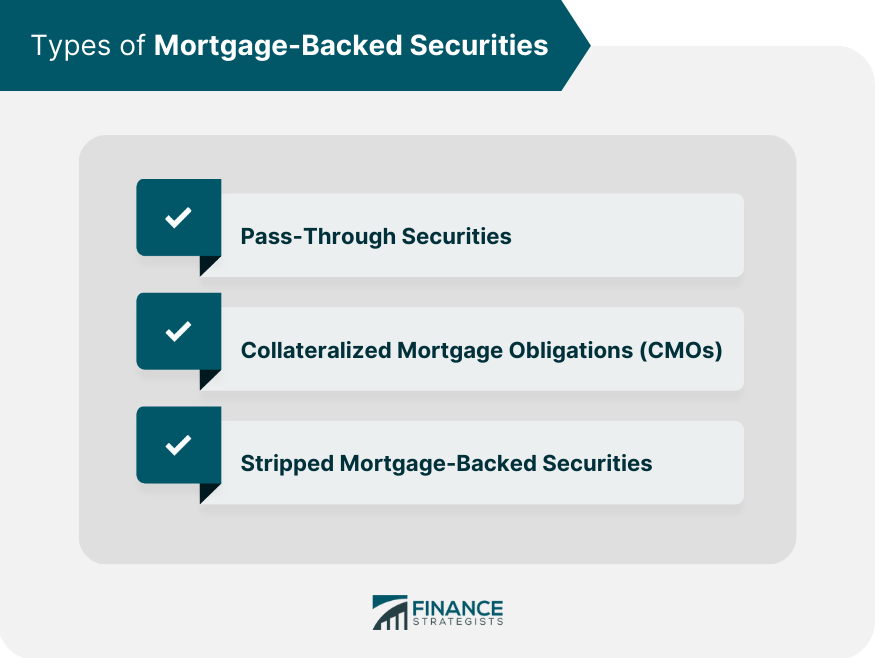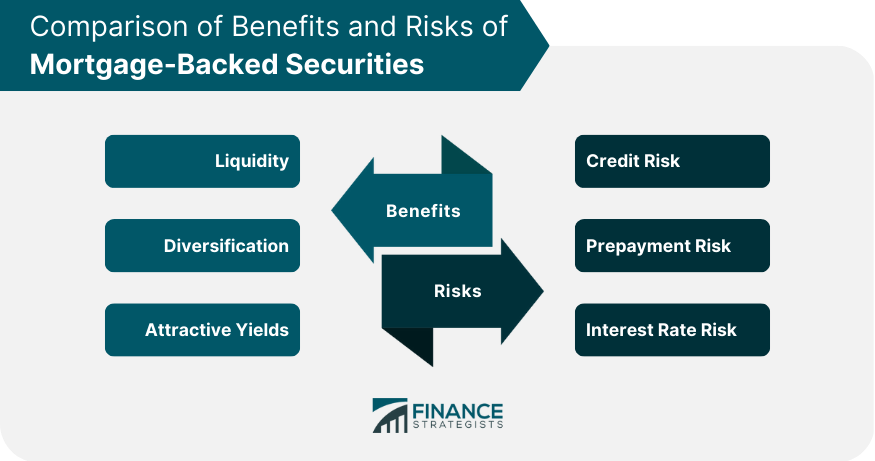Mortgage-backed securities (MBS) are investment products that allow investors to participate in the mortgage market without directly owning a mortgage. They are created by pooling individual mortgages together and then selling the resulting securities to investors. The history of MBS dates back to the 1970s, when the Government National Mortgage Association (Ginnie Mae) issued the first MBS. There are three main kinds of mortgage-backed securities: pass-through securities, collateralized mortgage obligations (CMOs), and stripped mortgage-backed securities. Pass-through securities are the simplest and most common type, while CMOs and stripped MBS are more complex. Pass-through securities are created by pooling individual mortgages and then selling the resulting securities to investors. The cash flows from the underlying mortgages are passed through to the investors, less any fees and expenses. Investors receive regular payments, which are based on the principal and interest payments made by the borrowers. Collateralized mortgage obligations are created by dividing the cash flows from a pool of mortgages into multiple tranches, each with its own risk and return characteristics. Each tranche may have a different interest rate, payment schedule, and maturity. CMOs can be more complex than pass-through securities, but they can offer greater flexibility and higher yields. Stripped mortgage-backed securities are created by dividing the cash flows from a pool of mortgages into two or more parts, each of which has its own risk and return characteristics. The most common type of stripped MBS is an interest-only (IO) security, which receives only the interest payments from the underlying mortgages. Another type is a principal-only (PO) security, which receives only the principal payments. Mortgage-backed securities are created by pooling individual mortgages and then selling the resulting securities to investors. The process begins with the origination of mortgages by banks or other lenders. The mortgages are then sold to a government-sponsored enterprise (GSE) or private issuer, who pools them together and creates MBS. The MBS are then sold to investors, who receive regular payments based on the cash flows from the underlying mortgages. The process of creating MBS involves pooling individual mortgages together and then dividing them into multiple tranches. Each tranche has its own risk and return characteristics, based on the cash flows it receives from the underlying mortgages. Tranches are created by dividing the cash flows into senior and subordinated classes, with the senior classes receiving the first claim on the cash flows and the subordinated classes receiving the remaining cash flows. The securitization process involves converting the cash flows from a pool of mortgages into securities that can be sold to investors. The cash flows are divided into multiple tranches, which are then sold to investors. The investors receive regular payments based on the cash flows from the underlying mortgages. The securitization process is designed to make the mortgage market more liquid and efficient. Mortgage-backed securities offer several benefits to investors. One significant advantage is liquidity. MBS are traded on the secondary market, which makes them generally more liquid than individual mortgages. Investors can buy and sell MBS more easily than they can buy and sell individual mortgages. Another benefit of MBS is diversification. Investors can diversify their portfolios by investing in a pool of mortgages, rather than individual mortgages. MBS allow investors to spread their risk across a large number of mortgages, reducing the impact of any one default or prepayment. Finally, MBS can offer attractive yields, especially compared to other fixed-income securities. Because MBS are backed by pools of mortgages, they typically offer higher yields than other fixed-income securities with similar credit ratings. While mortgage-backed securities offer several benefits to investors, they also carry several risks. Credit risk is one significant risk, which refers to the risk that borrowers will default on their mortgages, reducing the cash flows to investors. If a large number of borrowers default, investors may lose a significant portion of their investment. Prepayment risk is another risk associated with MBS. This risk refers to the risk that borrowers will pay off their mortgages early, reducing the cash flows to investors. Prepayment risk can be particularly problematic for investors in low-interest rate environments, as borrowers are more likely to refinance their mortgages. Interest rate risk is another risk associated with MBS. When interest rates rise, the value of MBS may decline, and when interest rates fall, the value of MBS may increase. This risk can be particularly significant for investors in long-term MBS, as changes in interest rates can have a greater impact on the value of longer-term securities. Mortgage-backed securities are investment products that allow investors to participate in the mortgage market without directly owning mortgages. There are three main types of MBS: pass-through securities, CMOs, and stripped MBS. MBS offer several benefits to investors, including liquidity, diversification, and attractive yields, but they also carry several risks, including credit risk, prepayment risk, and interest rate risk. The market for MBS is large and complex, with many different types of investors and market participants. The future outlook for the MBS market depends on a variety of factors, including interest rates, housing prices, and regulatory changes.What Are Mortgage-Backed Securities (MBS)?
Types of Mortgage-Backed Securities
Pass-Through Securities
Collateralized Mortgage Obligations (CMOs)
Stripped Mortgage-Backed Securities

How Mortgage-Backed Securities Work
Creation of Mortgage-Backed Securities
Pooling and Tranching
Securitization Process
Benefits of Mortgage-Backed Securities
Liquidity
Diversification
Attractive Yields
Risks of Mortgage-Backed Securities
Credit Risk
Prepayment Risk
Interest Rate Risk

Conclusion
Mortgage-Backed Securities (MBS) FAQs
Mortgage-backed securities (MBS) are investment products created by pooling individual mortgages together and selling them to investors. The cash flows from the underlying mortgages are then passed on to investors.
MBS offer several benefits to investors, including liquidity, diversification, and attractive yields. They can also provide exposure to the mortgage market without directly owning mortgages.
The risks associated with investing in MBS include credit risk, prepayment risk, and interest rate risk. Credit risk refers to the risk of borrower defaults, prepayment risk refers to early mortgage repayments, and interest rate risk refers to fluctuations in interest rates.
Mortgage-backed securities are created by pooling individual mortgages together and then dividing them into multiple tranches. Each tranche has its own risk and return characteristics, based on the cash flows it receives from the underlying mortgages.
The 2008 financial crisis was caused in part by the collapse of the subprime mortgage market, which significantly impacted the market for mortgage-backed securities. Many investors suffered significant losses, leading to increased regulatory scrutiny and changes in the market.
True Tamplin is a published author, public speaker, CEO of UpDigital, and founder of Finance Strategists.
True is a Certified Educator in Personal Finance (CEPF®), author of The Handy Financial Ratios Guide, a member of the Society for Advancing Business Editing and Writing, contributes to his financial education site, Finance Strategists, and has spoken to various financial communities such as the CFA Institute, as well as university students like his Alma mater, Biola University, where he received a bachelor of science in business and data analytics.
To learn more about True, visit his personal website or view his author profiles on Amazon, Nasdaq and Forbes.











